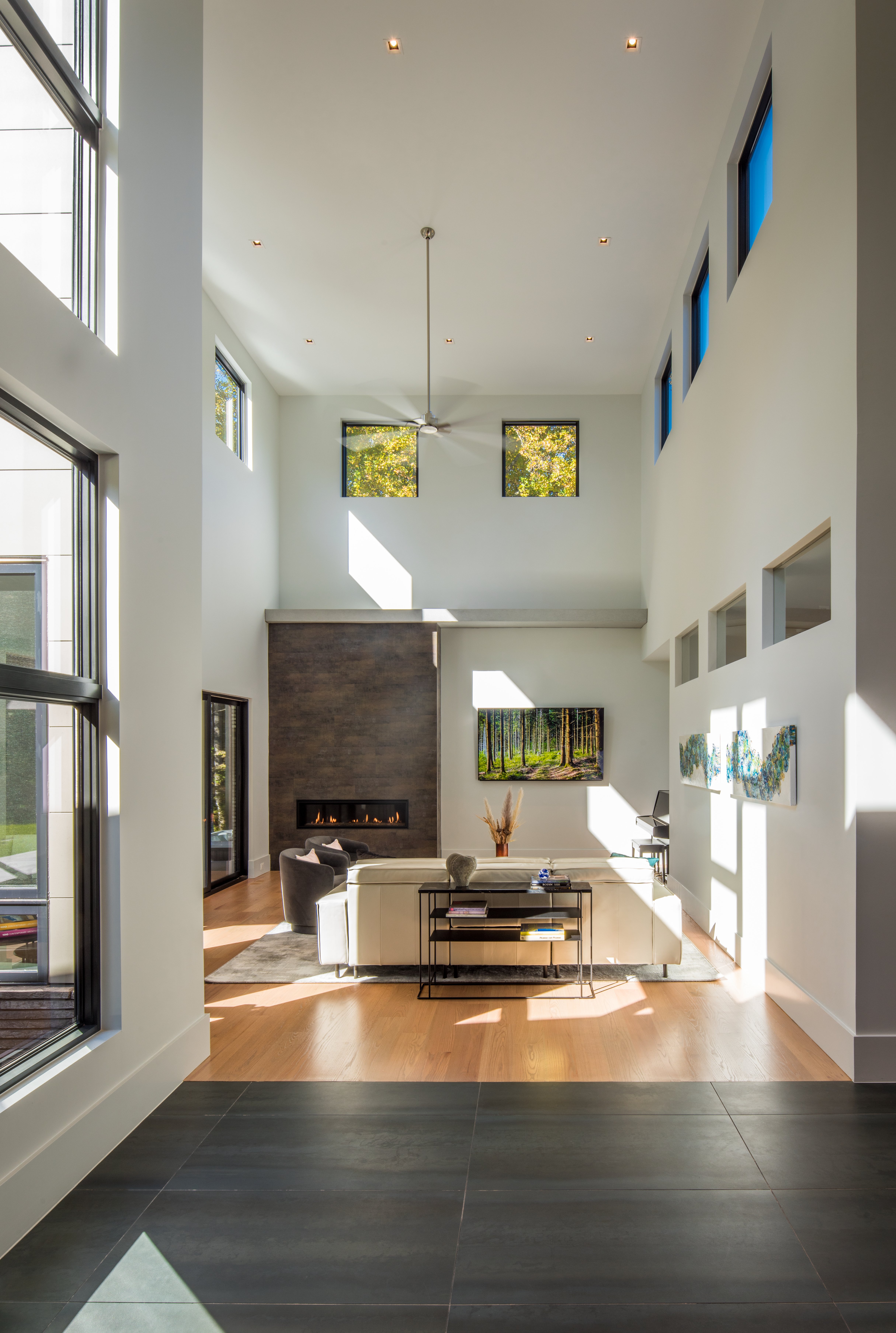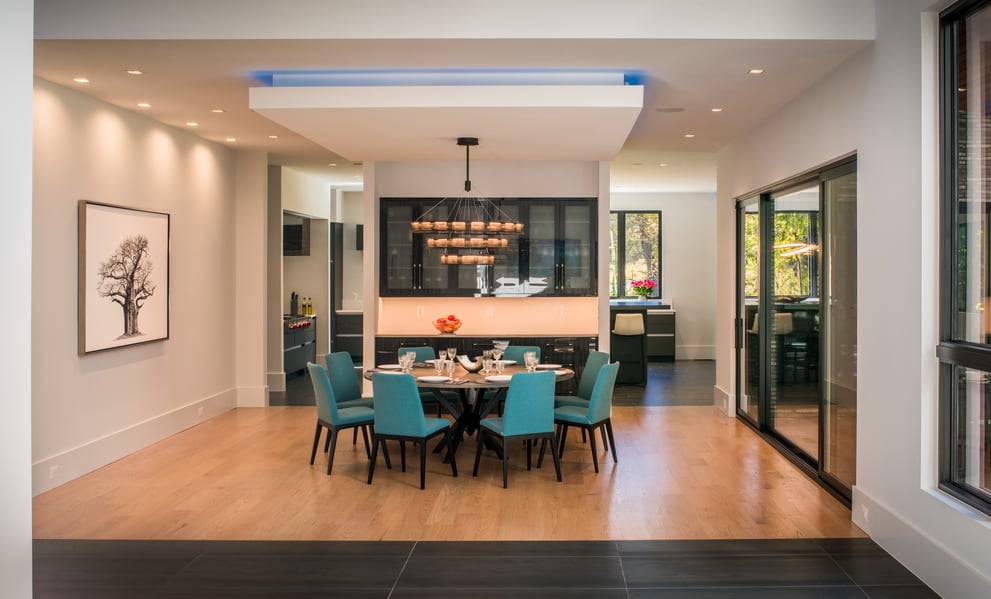
When designing a home, it's easy to focus on the objects that fill a space—furniture, artwork, lighting, and décor. However, one of the most impactful design elements is something that’s often overlooked: negative space. Negative space refers to the empty or open areas around objects, and its strategic use can elevate a room’s aesthetic, creating balance, flow, and a sense of calm.
Without careful consideration of the empty areas around objects, a room can feel cluttered and overwhelming, missing the opportunity to create a sense of balance, flow, and calm. Ignoring negative space can lead to designs that feel chaotic or overstimulating.
At AV Architects + Builders, we understand the critical role negative space plays in home design. Our expertise lies in creating homes that balance functionality and aesthetics, using negative space to highlight key design features while fostering an atmosphere of calm and openness. We’ve helped countless clients achieve this balance, ensuring that every room is carefully planned to allow for visual rest and thoughtful flow.
In this article, we’ll explore how to strategically use negative space to enhance your home’s design. You’ll learn why empty areas are just as important as filled ones, and how leaving space around furniture, artwork, and architectural features can elevate the overall aesthetic and functionality of a room. By the end, you’ll understand how embracing negative space can create a balanced, serene environment that makes your home truly shine.
What is Negative Space in Home Design?
Negative space, also known as "white space" in design, is simply the area that surrounds objects. It may be the wall space around a framed artwork, the gap between a sofa and a coffee table, or the unoccupied floor area in a room. The absence of objects in these areas allows for a more harmonious composition and lets your focal points—whether they be furniture, art, or architectural features—take center stage.
Why is Negative Space Important?
Negative space is a powerful design tool for several reasons:
1. Enhances Focal Points: When your home is crowded with objects, nothing stands out. By intentionally leaving space around a key piece of furniture, artwork, or an architectural feature, you draw attention to it and allow it to shine. For example, a statement piece of art on a large, mostly bare wall instantly becomes the focal point of a room.
2. Creates Balance and Flow: Negative space prevents a room from feeling cluttered or overwhelming. It provides a visual pause, allowing the eye to move comfortably around the space. This is particularly important in areas like open-concept living rooms or kitchens, where multiple zones need to feel connected yet distinct.
3. Adds a Sense of Calm: A home filled to the brim with objects can feel chaotic and stressful. Negative space adds breathing room, creating a sense of calm and serenity. This is particularly important in areas like bedrooms, where a peaceful environment is key.
How to Use Negative Space in Home Design
Incorporating negative space into your home design is all about intentionality. Here are some practical ways to harness its power:
1. Revise Your Space
The first step in using negative space is editing your home’s layout. Many homeowners make the mistake of overcrowding rooms with too many items—extra chairs, shelves overflowing with décor, or walls crammed with art. The key to a successful design is knowing when to stop. Choose a focal point for each room, like a fireplace, a large artwork, or a striking piece of furniture, and eliminate any distractions around it. By doing so, you’ll allow that focal point to take center stage and create a more refined, cohesive space.
2. Keep Some Walls Bare
Not every wall needs to be covered with art, shelving, or photos. In fact, keeping certain walls bare can add a sense of spaciousness and elegance to a room. For example, a minimalist living room with clean, empty walls makes any artwork or statement furniture stand out even more. This creates a gallery-like feel, letting your pieces have the attention they deserve.
3. Consider Furniture Placement
The placement of furniture directly affects how much negative space exists in a room. Instead of pushing every piece against a wall, try pulling your seating arrangements away from the walls to create a more inviting, conversational setup. Leave ample space between furniture items to maintain balance and flow. Avoid cramming furniture into every corner or allowing pieces to be too close together. This also allows for better movement through the room.
 The Vista House, Great Falls, Virginia, AV Architects + Builders, Photography by Maxwell Mackenzie
The Vista House, Great Falls, Virginia, AV Architects + Builders, Photography by Maxwell Mackenzie
4. Embrace Minimalism
While you don’t need to adopt a completely minimalist lifestyle, taking cues from minimalism in design can help you maximize negative space. Choose a few key furniture items or accessories, and give them room to breathe. For example, a bedroom with a simple bed, nightstands, and a bench can feel more spacious and relaxing than one filled with unnecessary furniture and knick knacks. Less truly can be more.
5. Use Negative Space to Frame Features
Negative space can be used to frame architectural details, art, or unique furniture pieces. For example, a dramatic fireplace or statement art piece will feel more impactful if it is surrounded by empty space rather than competing with nearby furniture or décor. Likewise, a well-placed piece of sculpture or a sleek modern chair can be framed by open floor space, making it a true focal point.
6. Play with Light
Negative space isn’t just about what’s absent—it’s about how light interacts with the space as well. By keeping areas open and uncluttered, natural light can travel more freely, making a room feel brighter and more expansive. Strategic lighting design, such as recessed lighting or pendant lights, can also enhance negative space by drawing attention to specific areas while leaving others in shadow, creating depth and dimension.
The Benefits of Negative Space
1. Visual Rest and Focus
Negative space gives the eyes a place to rest, allowing you to focus on what truly matters in the room. It reduces visual clutter, giving you a sense of calm when you enter the space. For example, a bedroom with carefully placed furniture and minimal décor feels more serene and restful than a room overcrowded with accessories.
2. Amplifies the Power of Design Elements
When done well, negative space amplifies the power of your design choices. A bold piece of artwork on a bare wall or a sculptural chair in the middle of an uncluttered room will command more attention than if they were competing with other elements in the space. The empty spaces highlight your design choices and create a sense of luxury and intention.
3. Maximizes Functionality
Negative space isn't just for aesthetics—it also enhances the functionality of a room. A kitchen with well-considered negative space, for example, is easier to move around in and more enjoyable to use. Similarly, a living room that isn’t overcrowded with furniture is more comfortable for entertaining and everyday living.
 The Solar House, Arlington, Virginia, AV Architects + Builders, Photography by Maxwell Mackenzie
The Solar House, Arlington, Virginia, AV Architects + Builders, Photography by Maxwell Mackenzie
How to Use Negative Space in Home Design
Negative space is a powerful tool in home design that allows you to create a balanced, serene, and visually appealing environment. By intentionally leaving areas around objects open, you let key design elements shine, enhance the functionality of a room, and create a sense of calm. When designing your home, remember that what you leave out is just as important as what you include.
If you’re ready to design a custom home tailored to your lifestyle, Schedule a Discovery Call with AV Architects + Builders today to discuss your project. For more inspiration and expert advice, visit our Learning Center for additional resources on creating the home of your dreams.
Sofia Alonso is currently the Content Manager at AV Architects + Builders, a family-owned architect-led design-build firm specializing in creating modern style homes for clients in Northern Virginia. Having been with the company since 2019, Sofia has demonstrated a strong commitment to the firm's ethos of providing high-end, luxury living experiences. Sofia holds a Bachelor of Science in Interdisciplinary Studies with a focus on Writing from the University of Virginia. With Sofia contributing to the firm's content strategy, clients can look forward to insightful, educational content that perfectly aligns with the luxurious, high-quality living experiences that AV Architects + Builders is renowned for.
Topics:





